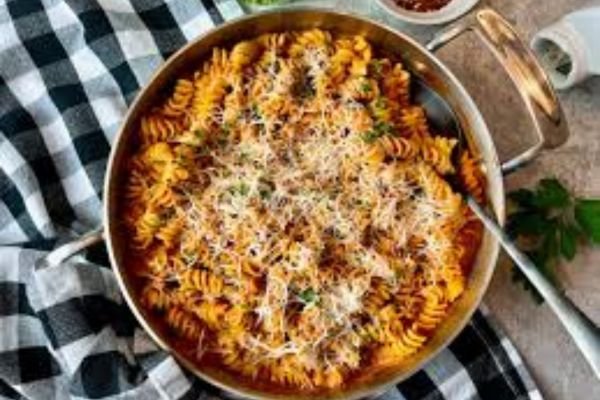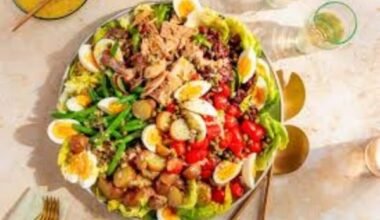If you’re anything like me, the kitchen is your happy place — a land of bubbling pots, sizzling pans, and mouthwatering aromas. But what happens when fresh produce is running low, the fridge looks like a ghost town, and all you’ve got are canned beans, pasta, and a questionable jar of peanut butter? Fear not, fellow food lover — this is where shelf stable food recipes shine like culinary superheroes.
Whether you’re stocking up for emergencies, cutting down on grocery runs, or just trying to make the most of your pantry stash, shelf stable ingredients can be both convenient and delicious. From comforting one-pot meals to surprisingly gourmet creations, these recipes prove that shelf-stable doesn’t mean boring. Let’s turn that can of tuna and bag of lentils into something amazing!
Shelf-stable food recipes refer to meals or dishes that use ingredients capable of lasting for months or even years without refrigeration. These recipes usually rely on canned, dried, or preserved goods that can be stored in pantries at room temperature. Shelf-stable food recipes offer more than just longevity—they provide a sense of security and assurance that you’ll always have something delicious and nutritious to eat even when fresh ingredients aren’t available.
Whether you’re planning meals for camping trips, stocking up for a potential emergency, or just want meals that don’t rely on refrigeration, shelf-stable food recipes make it all possible. From pasta dishes to soups, stews, snacks, and even desserts, shelf-stable food recipes can be creative, hearty, and satisfying.
Benefits of Shelf Stable Food Recipes
Shelf-stable food recipes offer numerous advantages. First, shelf-stable food recipes reduce dependency on fresh produce, which can spoil quickly. Second, shelf-stable food recipes minimize grocery trips, saving time and effort. Third, shelf-stable food recipes help maintain a consistent food supply during uncertain times. Shelf-stable food recipes are also budget-friendly because they often use inexpensive ingredients that can be bought in bulk and stored for long periods.
For those looking to simplify their cooking routine or improve their food security, shelf-stable food recipes are essential. Many people have started to realize the convenience and practicality that shelf-stable food recipes provide. They’re not just for emergencies—they’re smart meal solutions that can fit seamlessly into everyday life.
Pantry Essentials for Shelf Stable Food Recipes
To successfully prepare shelf-stable food recipes, it’s important to stock up on the right ingredients. Pantry staples that work well in shelf-stable food recipes include canned beans, lentils, tomatoes, tuna, salmon, and chicken. Grains like rice, quinoa, pasta, couscous, and oats also form the base of many shelf-stable food recipes.
Other common ingredients for shelf-stable food recipes include powdered milk, dry herbs, spices, oils, nut butter, shelf-stable plant-based milk, canned vegetables, and dehydrated fruits. Having a pantry filled with these ingredients ensures that you’ll always have what you need to whip up delicious shelf-stable food recipes without relying on the fridge.
With a well-stocked pantry, you can create endless shelf-stable food recipes that are full of flavor and nutrition. Whether you’re cooking for yourself, a family, or even a large group, shelf-stable food recipes make meal planning easier and more flexible.
Easy Shelf Stable Food Recipes for Every Occasion
One of the best things about shelf-stable food recipes is their adaptability. From breakfast to dinner, shelf-stable food recipes can cover every mealtime. For breakfast, try shelf-stable food recipes that use oats, dried fruits, and nuts for a hearty start to your day. For lunch and dinner, shelf-stable food recipes like pasta with canned tomato sauce, chili with beans, or tuna salad with crackers are quick and satisfying.
When you’re on the go or in a rush, shelf-stable food recipes provide fast meals that don’t compromise on quality. Even when camping or hiking, shelf-stable food recipes offer comfort and nourishment. They’re ideal for packing light while ensuring you still enjoy balanced and tasty meals.
Beyond basic meals, shelf-stable food recipes also include sauces, soups, dips, and even desserts. Yes, shelf-stable food recipes can be sweet too—try no-bake cookies made with oats and peanut butter or pudding using powdered milk and cocoa.

Creative Twists on Shelf Stable Food Recipes
Shelf-stable food recipes don’t have to be boring or repetitive. Shelf-stable food recipes can be gourmet when you get a little creative. Mixing canned protein with grains and spices can lead to flavorful rice bowls. Using jarred pesto, canned beans, and shelf-stable pasta, you can whip up an Italian-inspired dish in minutes. Adding coconut milk to lentils and curry spices to lentils brings an exotic twist to shelf-stable food recipes.
Even traditional recipes can be adapted into shelf-stable food recipes. For instance, a hearty tomato soup made with canned tomatoes, garlic powder, and dried herbs delivers comfort without requiring fresh produce. Similarly, shelf-stable food recipes using chickpeas and curry powder create vibrant, protein-rich meals with minimal effort.
You can also experiment by combining different textures and flavors. Add crunch with shelf-stable nuts, richness with canned coconut cream, or tang with vinegar and mustard. With a little innovation, your shelf-stable food recipes can feel gourmet and fresh.
Shelf Stable Food Recipes for Special Diets
Whether you’re vegan, vegetarian, gluten-free, or low-carb, there are shelf-stable food recipes for every dietary need. Plant-based shelf-stable food recipes include lentil soups, quinoa and bean salads, and rice bowls with dehydrated vegetables. For gluten-free diets, shelf-stable food recipes using brown rice, cornmeal, or buckwheat provide tasty and safe options.
Low-carb shelf-stable food recipes might include canned meats, nut butter, and shelf-stable cheeses paired with dehydrated vegetables or low-carb pasta alternatives. Regardless of your preferences or restrictions, shelf-stable food recipes can be adjusted to fit your needs while still delivering flavor, nutrition, and satisfaction.
The key to successful shelf-stable food recipes for special diets is reading labels and selecting versatile ingredients. Choose foods that serve multiple purposes in your shelf-stable food recipes and rotate them regularly to keep your pantry fresh.
Shelf Stable Food Recipes for Emergencies and Disaster Preparedness
One of the primary reasons people turn to shelf-stable food recipes is to prepare for emergencies or disaster scenarios. Whether it’s a natural disaster, power outage, or a global crisis, shelf-stable food recipes ensure you have access to essential nutrition when fresh food isn’t available. Shelf-stable food recipes serve as a lifeline during uncertain times.
When building an emergency food supply, shelf-stable food recipes should be at the core. Think about shelf-stable food recipes that require minimal preparation and water, especially when resources are limited. Ready-to-eat shelf-stable food recipes like canned soups, chili, or stews can be consumed directly if needed. Protein-packed shelf shelf-stable food recipes that include canned tuna, chicken, or legumes are crucial for energy and muscle health during emergencies.
Long-term storage shelf stable food recipes often focus on dehydrated or freeze-dried ingredients. With the addition of boiling water, shelf stable food recipes made from these ingredients quickly become nourishing meals. These shelf stable food recipes are designed to last years while retaining their flavor and nutritional value.
Preppers and survivalists rely heavily on shelf-stable food recipes to ensure food security. Having a variety of shelf-stable food recipes stored means you won’t face meal fatigue even during extended crises. Rotation is key—regularly use and replace ingredients to keep your shelf-stable food recipes fresh and effective.
Kid-Friendly Shelf Stable Food Recipes
Parents often struggle to find meals their kids will enjoy, especially when dealing with limited ingredients. Thankfully, there are plenty of shelf stable food recipes that kids love. From peanut butter sandwiches to cheesy pasta dishes using powdered cheese and shelf-stable milk, shelf stable food recipes make feeding children simple and stress-free.
Try shelf-stable food recipes like baked beans with crackers, instant oatmeal with dried fruits, or macaroni and tomato sauce using canned tomatoes and dry pasta. Sweet shelf-stable food recipes such as rice pudding made with canned milk and raisins are great treats that store well and satisfy picky eaters.
Parents can also turn shelf stable food recipes into fun, interactive activities. Let kids help assemble tacos using canned beans and corn or layer parfaits with shelf-stable yogurt and dried fruits. Shelf stable food recipes that involve kids in the kitchen encourage independence and creativity, even without access to fresh ingredients.
Shelf stable food recipes for children don’t have to be bland. Add cinnamon, vanilla extract, or honey to give meals a comforting, familiar taste. Stock your pantry with versatile items that can be turned into a wide array of shelf stable food recipes the entire family can enjoy.
Shelf Stable Food Recipes for Camping and Outdoor Adventures
Adventurers and campers understand the value of shelf-stable food recipes better than most. When you’re out in nature, refrigeration isn’t always an option. Shelf-stable food recipes offer the perfect solution for nutritious and energizing meals that are lightweight and easy to carry.
Portable shelf-stable food recipes include canned soups, instant noodles, trail mix, jerky, and oatmeal packs. These shelf-stable food recipes are compact, require little to no prep, and provide the energy needed for hiking or exploring. Shelf-stable food recipes for campfire cooking might include pasta with canned sauce or chili with dehydrated beans and spices.
Backpackers often rely on freeze-dried shelf shelf-stable food recipes, which only need hot water to rehydrate. These shelf-stable food recipes are lightweight and packable, making them ideal for extended trips. Shelf-stable food recipes that incorporate energy-dense ingredients like nuts, seeds, and nut butter ensure you stay full and fueled.
Camping is more enjoyable with warm, satisfying meals, and shelf-stable food recipes make that possible without the bulk of coolers or perishable items. When planning your next outdoor trip, pack a variety of shelf-stable food recipes to keep meals exciting and enjoyable.
Budget-Friendly Shelf Stable Food Recipes
One of the most attractive features of shelf-stable food recipes is their cost-effectiveness. Shelf-stable food recipes often use affordable pantry staples like beans, rice, pasta, canned vegetables, and sauces. These ingredients are not only inexpensive but also widely available, making shelf-stable food recipes accessible to all income levels.
Budget-conscious individuals love shelf stable food recipes because they stretch ingredients over multiple meals. For example, a bag of lentils can yield several servings of soups or stews. A box of pasta and a can of sauce create quick, low-cost meals. Shelf stable food recipes eliminate food waste by using ingredients with a long shelf life.
With smart planning, shelf stable food recipes help reduce impulse buying and reliance on takeout. Meal planning around shelf stable food recipes ensures you always have a meal option on hand, even when money is tight. It’s a proactive way to manage both your diet and your finances.
The value of shelf-stable food recipes goes beyond affordability—they also reduce the stress of constant meal planning and grocery shopping. With shelf-stable food recipes, a stocked pantry means you’re always prepared, regardless of your budget.
Global Cuisine and Shelf Stable Food Recipes
Shelf stable food recipes are not limited to traditional or local dishes. You can explore international cuisines using shelf stable food recipes that incorporate global flavors. Try shelf stable food recipes inspired by Indian cuisine with lentils, curry powder, and canned coconut milk. Mexican-style shelf stable food recipes may include black beans, canned corn, and tomato paste for a flavorful taco or burrito filling.
Asian-inspired shelf stable food recipes can use ramen noodles, soy sauce, canned vegetables, and peanut butter for delicious stir-fry or noodle bowls. Middle Eastern shelf stable food recipes might feature chickpeas, tahini, and spices like cumin and paprika. The possibilities are endless when you explore world cuisine through shelf stable food recipes.
Exploring different cultural dishes through shelf-stable food recipes is a great way to enjoy variety while still using long-lasting ingredients. These shelf-stable food recipes allow you to travel the world through taste, even from the comfort of your kitchen.

Conclusion
Who knew that shelf stable foods could taste this good? With a little creativity, some basic pantry staples, and your love for all things delicious, you can whip up hearty, satisfying meals that are anything but ordinary. Whether you’re prepping for a rainy day or just craving a no-fuss dinner, these recipes have your back (and your belly).
With shelf-stable food recipes, your kitchen is always stocked with possibilities. They allow you to embrace cooking with confidence, knowing that every ingredient on your shelf has a purpose. From comforting soups and hearty grain bowls to creative snacks and sweet treats, shelf-stable food recipes prove that practicality doesn’t mean sacrificing flavor or nutrition.
The versatility of shelf-stable food recipes means they can be adapted for every lifestyle, dietary need, and occasion. For families, shelf-stable food recipes offer simplicity and security. For individuals, shelf-stable food recipes offer independence and resourcefulness. And for everyone, shelf-stable food recipes offer a way to always stay nourished and prepared—no matter what life throws your way.







